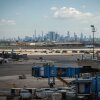
The fragile state of the U.S. air traffic control system was evident during the recent outages at Newark Liberty International Airport in New Jersey. The radar and communication problems led to hundreds of delays and cancellations. But it will be a lot harder to make up for decades of underinvestment and failed attempts to modernize the system. Andres Kudacki/Getty Images hide caption
toggle caption
Andres Kudacki/Getty Images
WASHINGTON — This week, the head of the Federal Aviation Administration laid out an ambitious goal of bringing the U.S. air traffic control system into the 21st century.
"The whole idea is to replace the system," acting FAA administrator Chris Rocheleau explained to the House Appropriations Committee during a hearing on Wednesday. "No more floppy disks or paper strips."
It's a goal that has eluded all of Rocheleau's predecessors. Walking into many of the nation's air traffic control towers is like stepping back in time. Technology from the 20th century is still very much in use today — including, yes, floppy disks, paper flight strips, and computers running Windows 95.
More than a third of the nation's air traffic control systems are unsustainable, according to an FAA assessment from 2023, and some are starting to fail.
The fragile state of the system became glaringly obvious during the recent radar and communication outages that led to hundreds of delays and cancellations at Newark Liberty International Airport in New Jersey.
"This is the most important infrastructure project that we've had in this country for decades," Transportation Secretary Sean Duffy said during a press conference at the Newark airport on Monday. "Everyone agrees, this is non-partisan. Everyone knows we have to do it."
Duffy wants a brand new air traffic control system, and he has broad backing across the aviation industry: from the union that represents air traffic controllers, to trade groups for airlines and manufacturers. They've all signed on to a coalition called Modern Skies, which produced a TV ad leaning heavily on 1980s nostalgia with portable cassette players and leg warmers.
"That was then," the narrator says. "But four decades later, floppy disks are still being used to run our air traffic control system.
It's easy to joke about outdated equipment. But it will be a lot harder to make up for decades of underinvestment and failed attempts to modernize the system.
"At its core, it's a money problem," said Michael Huerta, a former FAA administrator under President Obama. Huerta also chaired a safety review team that looked at the air traffic control system and reported its findings to the FAA two years ago.

Transportation Secretary Sean Duffy holds a news conference at Newark Liberty International Airport, where he announced the reopening of a major runway at the airport, nearly two weeks ahead of schedule on Monday in Newark, N.J. Delays and cancellations have plagued Newark, one of the nation's busiest airports, for months. Spencer Platt/Getty Images hide caption
toggle caption
Spencer Platt/Getty Images
"The FAA has been asked to do more with less, essentially," Huerta said in an interview.
The Trump administration has not said how much a brand new air traffic system will cost. Secretary Duffy estimates the price tag is in the tens of billions of dollars, and is aiming to complete it within four years.
The Transportation Department is asking private companies for their ideas on how to pull that off. This week, the FAA put out a Request For Information from an "integrator" that could take the lead in building the new system, and it's inviting companies to pitch their "the best and brightest ideas and new technologies" in a series of so-called "Industry Days" next week.
"It's an extraordinarily ambitious plan," said David Grizzle, a former chief operating officer of the FAA who also participated in the safety review team. He's encouraged to see that the Trump administration is looking outside of government for help.
But he also sees some possible obstacles. The FAA has spent a lot of money on upgrades before, Grizzle says. But it hasn't always seen a big payoff.
"The FAA has not been allowed to shut down old ancient equipment," Grizzle said. "So as a result of that, even the money that they have for equipment, more than 90% goes to fund old equipment."
There are other potential roadblocks, too.
One big question is what to do about the 21 air traffic control facilities that manage high-altitude traffic. Many of them are old and falling apart. The DOT has proposed building only 6 new ones, leaving unclear exactly what would happen to the others, while suggesting that the FAA might want to "consolidate" these facilities to save money.
"I think that consolidation is something that needs to be part of this plan," agrees Huerta. "Everyone who is familiar with the air traffic system recognizes that we probably don't need the number of facilities which were built at a time when technology was very different, that we can get by with a smaller number."
But the politics around consolidation will likely be brutal, Huerta concedes, as members of Congress jostle to protect facilities in their own districts. And many in the industry say they're skeptical about the Trump administration's aggressive timetable.
"There's no way that they can complete all of that within four years," Grizzle said. "But if they could merely start in each of the elements and get a running start, that would be tremendous."

 3 months ago
83
3 months ago
83



















































